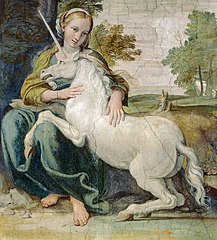
Unicorns are elusive creatures, though I’m not sure they can be called shy.
In the Middle Ages, about the time unicorns became officially magical, people thought the creatures symbolized purity. This is probably why the standard color for unicorns is white.
On the other hand, unicorns were said to be vain creatures who happily spent hours admiring themselves. This could imply unicorns committed the deadly sin of pride, a view contradicting the idea that the unicorn symbolized Christ.
Unicorns were also ferocious, and could only captured by using a virgin to set a trap. According to Isidore of Seville, “If a virgin girl is placed in front of a unicorn and she bares her breast to it, all of its fierceness will cease, and it will lay its head on her bosom, and thus quieted is easily caught.”
Hunters sought the unicorn both as a trophy, and for the medicinal powers of its magical horn, which could command a king’s fortune. [See Unicorn Tales]
The Unicorn Tapestries
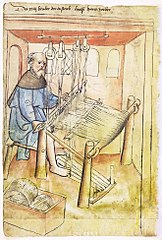
The Unicorn Tapestries, sometimes called The Hunt of the Unicorn are a sequence of seven tapestries woven between 1495 and 1505. Each panel measures 12 feet tall by 14 feet wide, and is woven with wool and silk thread. Three dye plants were used to create the colors: madder for red; woad for blue, and weld for yellow. The colored threads were wrapped around stronger threads to create the design.
Weavers worked side-by-side using small tools. They worked only during the day, because candlelight distorted the colors. A talented artist could weave about one square inch an hour. It was painstaking work to create a visual record of an idealized hunt.
In the first panel, The Hunters Enter the Woods to begin their quest. Among the 101 plants in the tapestry is the cherry tree, a symbol of harmony, behind the hunters and a date palm, symbolizing the Christian victory of the spirit over the flesh, standing in front of the hounds. Traditionally, hounds scouted, chased, and attacked the hunters’ prey.
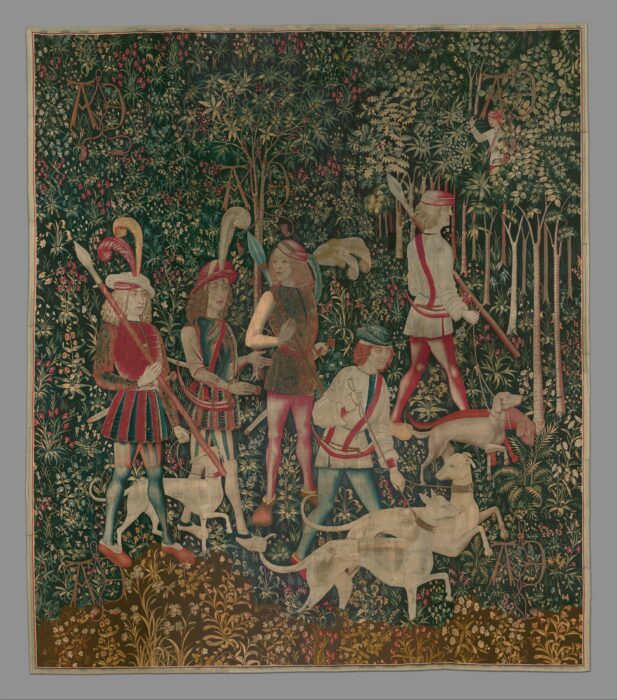
The Hunters Enter the Woods 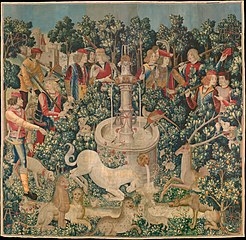
The Unicorn Purifies Water
The Unicorn Purifies Water. Here the hunters have found their quarry, but aren’t entirely sure how to attack it. Tradition says a unicorn may not be harmed while performing a magical act. In this scene, the unicorn kneels in front of a fountain that has a pair of goldfinches perched on top. Goldfinches symbolized a foreknowledge of Christ’s crucifixion. Near the stream, there are plants used as medieval antidotes to poison: sage, marigolds, and orange.
The Unicorn Crosses a Stream. The hunters prepare to strike the fatal blow, but the unicorn has other ideas. Wounded, the animal tries to escape across a stream before launching a counter attack in The Unicorn Defends Himself.
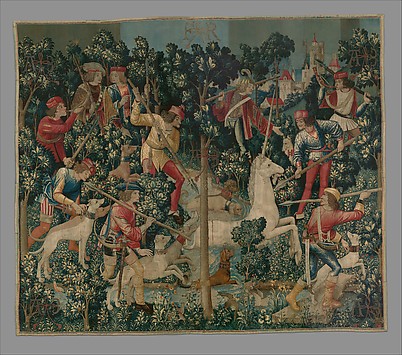
The Unicorn Attacked 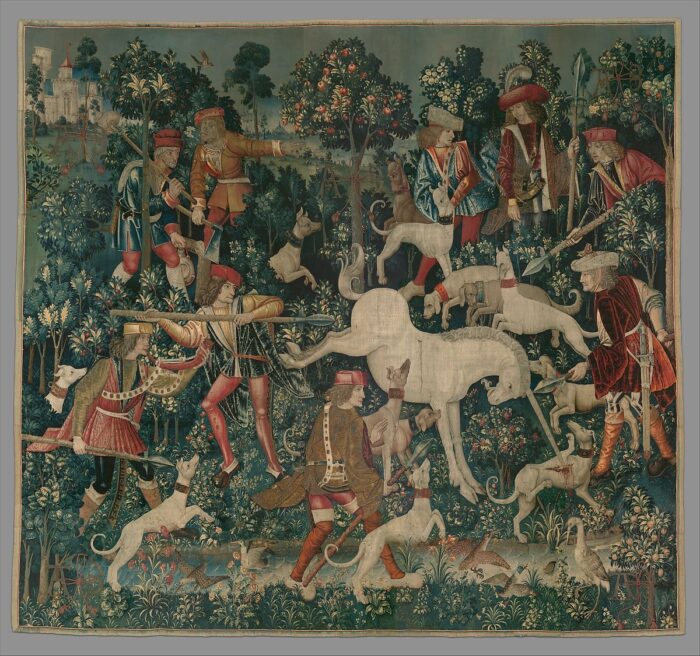
The Unicorn Defends Himself
The wounded unicorn escapes the hunters, only to be seduced by a maiden. In The Unicorn Surrenders to a Maiden, the animal is so tame he allows a greyhound to lick his wounds. Alas, the peaceful moment doesn’t end well for the unicorn.
When the maiden gives the signal, the hunters drive their lances into the unicorn’s neck, chest, and back. The animal falls. There is a large holly tree in the background, another piece of symbolism comparing the unicorn to Christ.
On the right side of the panel, The Hunters Return to the Castle. They carry their dehorned prey on a sling, presumably in expectation of lavish rewards.
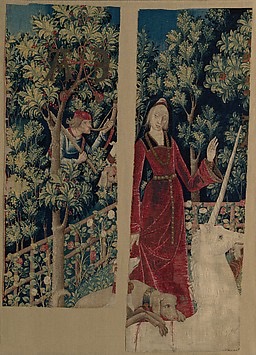
The Unicorn Surrenders to the Maiden 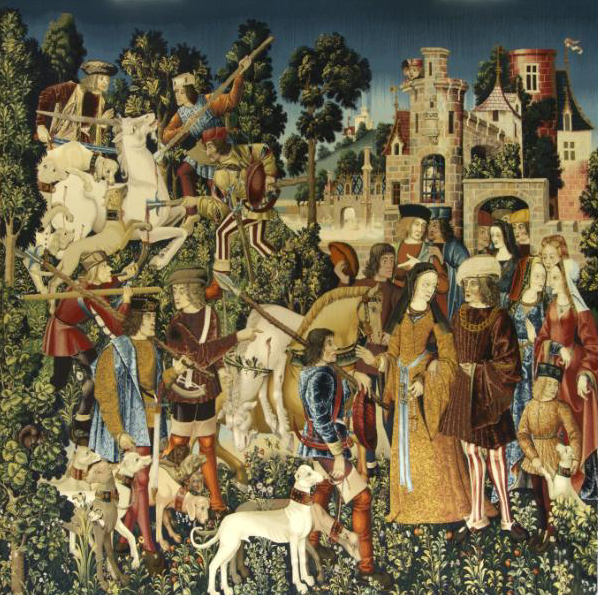
The Hunters Return to the Castle
The last tapestry in the series may carry out the theme of a resurrected Christ, or it may refer to the more romantic elements of unicorns. The Unicorn in Captivity depicts a contented animal who is contained, but could easily escape if he wished. Symbolism in the tapestry refers to marriage and fertility. Various fertility symbols include the pomegranate, with its many seeds, and the medieval fertility aids of wild orchid and thistle.
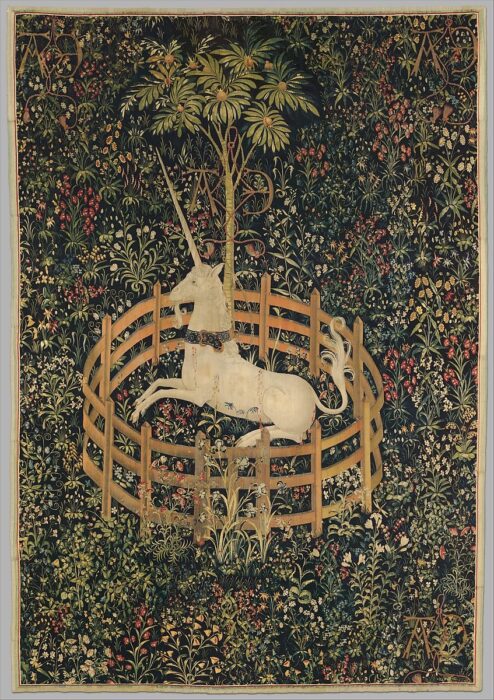
Vain, playful, strong, and possessed of healing powers, unicorns are magical creatures who cannot save themselves, but live on in our imaginations.
🦄🦄🦄
Illustrations
The Virgin & the Unicorn by Domenichino
Weaver, 1425.
Unicorn Tapestries. Cloisters. Metropolitan Museum of Art.

Sandra Wagner-Wright holds the doctoral degree in history and taught women’s and global history at the University of Hawai`i. Sandra travels for her research, most recently to Salem, Massachusetts, the setting of her new Salem Stories series. She also enjoys traveling for new experiences. Recent trips include Antarctica and a river cruise on the Rhine from Amsterdam to Basel.
Sandra particularly likes writing about strong women who make a difference. She lives in Hilo, Hawai`i with her family and writes a blog relating to history, travel, and the idiosyncrasies of life.


Hi Sandra,
It is always interesting to think, did they possibly live, and were hunted down thus no longer with us? Thank you for a good read.